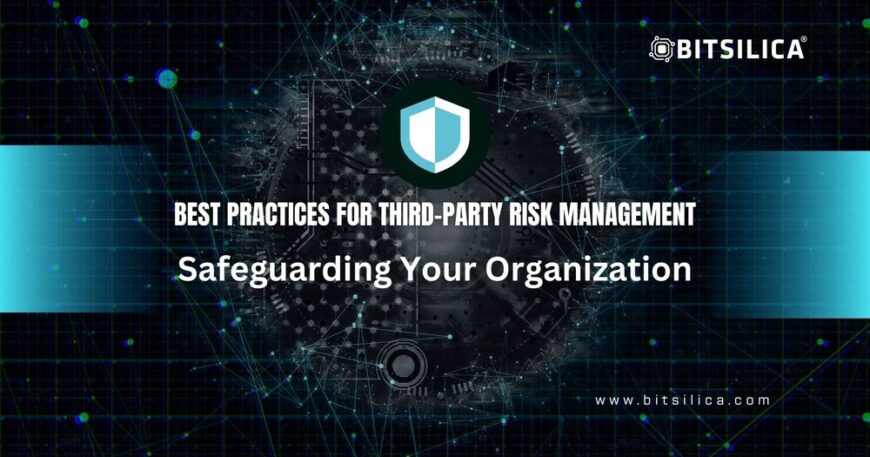Best Practices for Third-Party Risk Management: Safeguarding Your Organization
Introduction
Third-party risk management is essential for protecting your organization from potential risks associated with external vendors, suppliers, and partners. As organizations increasingly rely on third parties for various services and products, it is crucial to ensure that these relationships do not compromise your security posture. This blog post will explore best practices for managing third-party risks, helping you safeguard your organization from potential threats.
Understanding Third-Party Risk Management
Third-party risk management involves identifying, assessing, and mitigating risks associated with external entities that have access to your organization’s data, systems, or operations. This process helps ensure that third-party relationships do not expose your organization to undue risks.
Key Components of Third-Party Risk Management:
• Risk Assessment: Evaluating the potential risks posed by third parties.
• Due Diligence: Conducting thorough evaluations of third parties before engaging with them.
• Contract Management: Establishing clear terms and conditions to mitigate risks.
• Monitoring and Auditing: Continuously monitoring third-party activities and conducting regular audits.
Example: In 2013, a major retailer experienced a significant data breach due to vulnerabilities in a third-party vendor’s systems, resulting in the exposure of millions of customer records. This incident underscored the importance of robust third-party risk management.
Conducting Thorough Risk Assessments
Evaluating the risks associated with third parties is the first step in effective third-party risk management.
Best Practices:
• Identify Risks: Identify potential risks, including data breaches, compliance violations, and operational disruptions.
• Assess Impact and Likelihood: Evaluate the potential impact and likelihood of identified risks.
• Prioritize Risks: Prioritize risks based on their potential impact on your organization.
Example: A financial institution conducted comprehensive risk assessments for its third-party vendors, identifying high-risk vendors and implementing additional security controls to mitigate potential threats.
Performing Due Diligence
Conducting thorough due diligence helps ensure that third parties meet your organization’s security and compliance requirements.
Best Practices:
• Background Checks: Perform background checks on third-party vendors, including their security practices and financial stability.
• Compliance Verification: Verify that third parties comply with relevant regulations and industry standards.
• Security Assessments: Conduct security assessments to evaluate third parties’ security controls and practices.
Example: A healthcare organization performed due diligence on its third-party vendors, ensuring that they complied with HIPAA regulations and had robust security measures in place.
Establishing Clear Contract Terms
Clearly defined contract terms help mitigate risks by establishing expectations and responsibilities for both parties.
Best Practices:
• Security Requirements: Include specific security requirements and standards that third parties must meet.
• Data Protection Clauses: Ensure contracts include clauses related to data protection, confidentiality, and breach notification.
• Termination and Exit Plans: Define termination and exit plans to ensure a smooth transition and data protection if the relationship ends.
Example: A technology company included stringent security requirements and data protection clauses in its contracts with third-party vendors, reducing the risk of data breaches and compliance violations.
Continuous Monitoring and Auditing
Ongoing monitoring and auditing of third-party activities help ensure that they adhere to your security and compliance requirements.
Best Practices:
• Regular Audits: Conduct regular audits of third-party vendors to assess their compliance with security and contractual requirements.
• Performance Monitoring: Continuously monitor third-party performance and security practices.
• Incident Reporting: Establish clear procedures for third parties to report security incidents and breaches.
Example: A retail company implemented continuous monitoring and regular audits of its third-party vendors, identifying and addressing potential security issues before they could cause harm.
Implementing a Third-Party Risk Management Framework
A structured framework helps streamline and standardize third-party risk management processes.
Best Practices:
• Policy Development: Develop comprehensive third-party risk management policies and procedures.
• Risk Management Tools: Use risk management tools to automate and streamline risk assessments, due diligence, and monitoring.
• Training and Awareness: Provide training and resources to employees responsible for managing third-party relationships.
Example: A multinational corporation implemented a third-party risk management framework, including policies, procedures, and automated tools, enhancing its ability to manage and mitigate third-party risks effectively.
Ensuring Compliance with Regulations
Compliance with relevant regulations and standards is essential for managing third-party risks and avoiding legal and financial penalties.
Best Practices:
• Identify Applicable Regulations: Determine which regulations and standards apply to your organization and third-party relationships.
• Compliance Audits: Conduct regular compliance audits to ensure that third parties adhere to regulatory requirements.
• Documentation and Reporting: Maintain detailed documentation of third-party risk management activities and compliance efforts.
Example: A financial services firm conducted regular compliance audits of its third-party vendors, ensuring adherence to PCI DSS and other relevant regulations, and avoiding regulatory penalties.
Conclusion
Effective third-party risk management is crucial for protecting your organization from potential threats associated with external vendors, suppliers, and partners. By conducting thorough risk assessments, performing due diligence, establishing clear contract terms, continuously monitoring and auditing, implementing a structured framework, and ensuring compliance with regulations, organizations can significantly reduce third-party risks. Stay vigilant and proactive in managing third-party relationships to safeguard your organization’s security and reputation.





